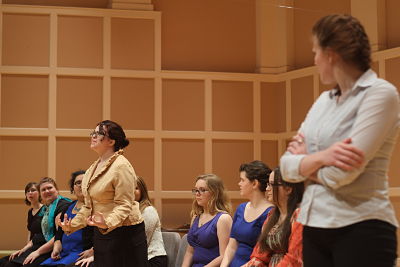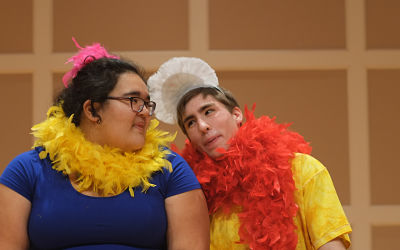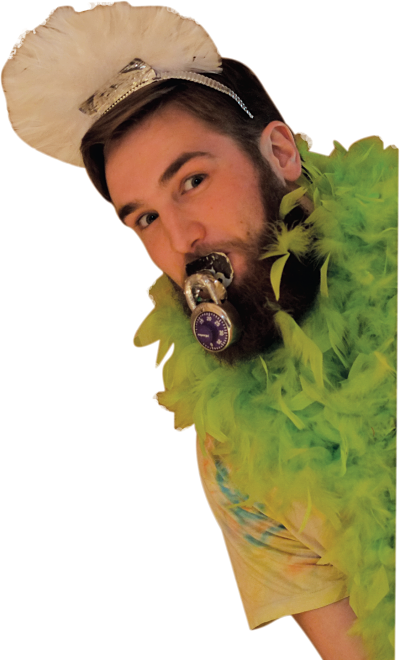Jumpstarting J-Term 2015
Revamped J-term courses explore new ideas and disciplines.
Senior Max Hohlen acts out a scene as Papageno from ‘The Magic Flute” in the new Opera and Musical Theatre J-term.
February 18, 2015
Cold winter days and long hours in the classroom can take take their toll on student morale, but 2015 ushered in a number of new additions to the J-term curriculum to help revamp the program. These courses were focused on high-impact learning and utilized the longer days to include unique content and opportunities for students and faculty alike.
This initiative coming straight from the Provost’s office was 18 months in the making, according to Associate Provost Mike Reynolds. Reynolds, who played a large role in getting Provost Eric Jensen’s new initiatives for J-term up and running, said it was important to find out what was needed on campus and how special terms like J-term and May-term, fit into the curriculum.
“There seems to be a sense that the requirements aren’t being there, the needs aren’t being met. We had fallen into certain ruts…about what J-term was for,” Reynolds said.
To combat this, a model was developed where people could develop a J-term curriculum, apply for grants to fund it, and, if accepted, work with an advisor familiar with creating J-terms to ensure the class was structured to make the most of the term. Reynolds said the goal of the model was to create new J-term classes that would provide the “opportunity for in-depth, full-on immersion into…a non-traditional subject that allow people to think differently and explore more than they do” in semester-long courses.
One course that accomplished this was Opera and Musical Theatre Workshop, co-taught by Kathy Thomsen and Debora Carbaugh. Students learned a mix of classical and musical theater songs, attended a professional opera performance and ended the term with a concert of their own, dressed in full costume to fit each setting.

Students in the Musical Theatre and Opera Workshop perform “Forget About the Boy” from “Thoroughly Modern Millie.”
“I thought it was actually really awesome,” said junior Melissa Thompson. “It taught me how to practice more efficiently…in a very short time period.”
Thompson said she wished there were more opera pieces involved, but Emma McIntosh, a senior who is involved in both the theater and music departments, said she wished more of the latter would have been selected.
“I feel like there’s really a gap at Hamline for people who want to do musical theater. There’s not a lot of blending of departments and Macalester does it a lot,” McIntosh said. “[The opera course] is both theatrical and music and different departments can learn from doing more of that.”
“We knew this was kind of an opportunity students really needed and would take advantage of,” Thomsen said. “We tried to cast people to fit their voice types. The problem with that is…the literature is vast.”
Thomsen said student opinion was considered when selecting the pieces, but when it came to narrowing the nearly 60 options to 17, the system was much less democratic.
“We had a three-hour meeting over many cups of coffee,” Thomsen said. “We had to make it fit and be realistic for the students. A lot of what we did was hard, but doable in the amount of time.”
Thomsen said they worked with Religion professor Deanna Thompson to fine-tune the course. Thompson served as the advisor for all of the new J-terms because of her experience with teaching J-term courses almost every semester.
“I wanted to become a part of that because I’m worried about [J-term] being dropped. I believe it provides great opportunities, whether it’s studying abroad, taking these outside-of-the-box classes, or digging deep into a subject,” Thompson said. “We become a little community. People are plugged in; they’re not distracted, which…allows for a kind of transformation. There’s an investment that students just can’t make in the semester.”
She clarified it’s not impossible for that level of investment to happen during the semester, but it’s more likely in a special term when the one class is the primary focus and students are not juggling a number of important classes and responsibilities. She also said J-terms are beneficial because they give students some breathing room between semesters and allow first-years, in particular, to get to know other students on a deeper level because of the amount of time they are spending together each day.
“I think J-term is something really unique that should be protected by Hamline,” Chemistry Professor Deanna O’Donnell said.
O’Donnell created a course called Lifecycle of a Painting, which utilized various chemistry tools to determine the chemical compositions of paintings, analyze texture and reveal any former drawings beneath the paint.

These replica Renoir and Matisse paintings were created for the Lifecycle of a Painting J-term, which paired art with chemistry.
“I wanted it to be a class where students would find out how artists created the art and what goes into that,” O’Donnell said. “With everything they had to do, they couldn’t destroy the art. It’s not a bottle of chemicals on the shelf you can use up. You have to treat the art with respect.”
The nature of this work required students to have a background in chemistry, but sought to increase student’s understanding of the art world. She had a particular focus in painting restoration.
“The world of conservation is a very collaborative field. I wanted students to understand that chemists play a small role in that big field, so they had to have some art background to go along with it,” O’Donnell said. “They’re used to a chemical language. To look at [art] through that lens made it more accessible.”
Every Friday, her students had a guided tour of the Minneapolis Institute of Arts in a different part of the collection to help acquaint them with the discipline.
Miranda Chimzar, a Hamline senior, was one of the few students in O’Donnell’s class who isn’t a chemistry major, but had enough background in the subject to be accepted into the course. Chimzar said she loved exploring the interaction between what seemed to be unrelated subjects.
“It’s super interesting to combine what people normally consider very different classes and don’t think they intertwine. Seeing the interface of where they meet is very cool, and I appreciate getting a broader context of what I’m doing in class. Two of my favorite classes have been interdisciplinary,” Chimzar said, also referencing Disease in Society, co-taught by Katharine Bjork and Betsy Martinez-Vaz. “I think it’s a good way to introduce students to topics they may otherwise not be comfortable examining.”
Reynolds supports the idea of having more interdisciplinary classes, but they are not common for a number of reasons, including the level of difficulty in trying to coordinate them.
“Interdisciplinary teaching is something that many people want, but it’s hard to get approval,” Reynolds said. “It’s not enough to say ‘here’s two kinds of content, how do they connect?’ The teachers have to find a way to integrate them for the students.”
This process of developing a fluid course from two different areas of study is one that makes creating interdisciplinary courses a more difficult task when dealing with schedule and time restraints during the semester. Many of these courses would not have been possible to execute without J-term.
“This is not a one-person job,” Thomsen said of her opera course. “[Carbaugh] is a trained singer. I’m a trained pianist. We needed both our skills to do it.”

First-year Hattie Hsu and senior Jarek Luiken perform the “Papageno” duet from “The Magic Flute.”
The classes exemplified an even wider variety of focus, including options such as Student Affairs in Today’s Society taught by Dean Alan Sickbert and Community Organizing 101: People, Power, Change taught by Jim Scheibel.
Despite any challenges for faculty and staff or student fees that came from the creation of these J-terms, the student response was positive overall and will help guide how Hamline moves forward with their special term programs.
“CTL will have more money going forward…to fund J-term exploration,” Reynolds said. “We can do workshops and lunches…to fuel some creative inspiration for what to do next year. People are constantly reflecting on what they do and want to try something new. The more input we get from faculty, staff, and students about what makes J-term better, the more we can properly allocate resources for it.”
Tell us what you would like to see in a J-term class! Send suggestions to thehamlineoracle@gmail.com.


